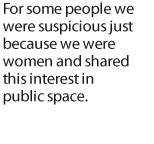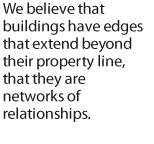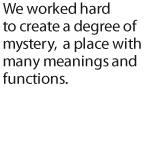
Interview



“Who is it??”, Liza happily shouts into her cell phone. She is standing on a droning vaporetto, the connection is not good. We have planned to meet in front of the British Pavilion at the Architecture Biennial in Venice for the interview, and Liza Fior, one of the curators of the British Pavilion, is rather busy. Constantly people approach her to ask questions about the exhibition, discuss organizational problems or simply congratulate her on her work. After we have led her to a quiet room, she tells us that she did not want to give the interview alone. “muf is more than just myself! You cannot only speak to me!” Quickly, she calls Alison Crawshaw and Caitlin Elster, who happen to be nearby, to ask them to join us. “Let’s get as much muf together as we can”, she smiles broad and remains happy and jolly, yet highly concentrated, throughout the following interview.
Liza, muf was founded back in 1995 by four friends; why would friends set up an architecture studio together?
Liza Fior:
Well, we did not really plan to establish an architecture studio; it began as a
conversation. I knew Juliet Bidgood from architecture school and I had met the artist
Katherine Clark when we were both working for the Architectural Association in
London. The fourth founding member of muf was Katherine Shonfield, a theorist and
writer who sadly died in 2003. She was kind of stepping in and out, coming to see
what we were doing and discussing it with us.

If it was coincidental, how did it start?
Liza Fior:
We had begun with a feasibility study to see if there should be a museum of women’s
art in Britain. But we came to the conclusion that there was too much irony in the
idea of taking all the women’s work out of the basements where it was, not being
shown in the museums, and just putting it into another container. Ricky Burdett
invited us to exhibit this work which we did as an installation called “Purity and Tolerance”.
Then we were suddenly short-listed for an invited competition at an art gallery
in Warsaw – again looking at the limits of a cultural institution. We were very surprised,
because only six studios were invited and we did not even have a “real studio”.
So that’s sort of how muf came about – all of this happened over just a few months.
Why did you choose the name “muf”?
Liza Fior:
When we were selected for the Warsaw art gallery we needed a name to write on the
form. Some male architects had nicknamed us “the mufia”, because obviously they
found it terrifying that these women were gathering. In England muf sound’s a bit, a
little … well, provocative.

In your short self-description, you write as a ps that “muf does not stand for modern urban fabric”. Why is that important for you to state?
Liza Fior:
Because that name was given to us by people who are uncomfortable with what
muf means down in Hicksville, so they were trying to make it more decent. For some
people we were suspicious just because we were women and shared this interest in
public space while coming from disparate disciplines of art, architecture and urban
theory. Back in 1995, during the last Conservative administration, it was super
eccentric to be interested in public space. Money was only spent on public spaces if
you could prove that you were bringing private investments into a neighbourhood.
So muf’s early work was a creative critique of that.
And just 15 years later, you are, as curators of the British Pavilion, the national representatives of the UK here in Venice.
Liza Fior:
Yes, and with another Conservative administration, and with a Conservative Minister
of Culture opening the pavilion tomorrow. So we have sort of come full circle again.
You have described the “Villa Frankenstein” as a typical muf project – what’s so typical about it?
Liza Fior:
The exhibition focuses on John Ruskin’s “Stones of Venice”, which is also why we
called the pavilion, somewhat ironically, “Villa Frankenstein”. We are showing how the
British have been obsessed with the city of Venice for quite a long time. Our exhibition
aims to re-animate this exchange because we believe that buildings – even
this one, which is isolated from the city almost like a British embassy – have edges
that extend beyond their property line and that they are networks of relationships.
Throughout the three months of this Biennial we are contriving the pavilion is a
site for disparate encounters - those interested in the fragile lagoon (the scientists)
and those representing the fragile neighborhoods of Venice (the schools). But it is
of course really difficult to turn this place into a real public space. After all, it is an
exhibition and you have to pay to enter the Giardini. We are still negotiating with the
organizers to let people enter the pavilion without paying, but I don’t know if we will
succeed. That process is as much the project as the large model of the „stadium of
close looking“.

So there it is again, your interest in public space.
Liza Fior:
Absolutely. There are so many public spaces resulting from private investments that
are so anodyne because they do not allow room for complexity. Public spaces should
serve more than one purpose. We have to make more undetermined spaces.
How do you do that as a planner? Do you have an example of that in your work?
Alison Crawshaw:
One of the most recent examples would be the Barking Town Square. We worked
very, very hard to create the square with a degree of mystery, with the possibility for
escape. It is meant as a place with many meanings and functions.
Liza Fior:
We had this ambition to make a multi-functional space and it is now actually being
used in that way. It is not a one-liner, not the manifestation of just one story. Each
time Alison goes there, she comes back with a new tale to tell.
Alison Crawshaw:
They have CCTV surveillance there, which is very good for us because now we have
complete documentation of everything that goes on: People doing karate on the
stage, climbing the trees, reading books, having picnics, taking wedding photographs.
People are really making use of the square.

Liza Fior:
Along with the building programme, we draw in the complex client developer, local
authority and found ways into the neighborhood itself, working with the master
bricklayers from the local building college for example.
You always try to form networks with the local communities?
Liza Fior:
And with experts from other fields. For the British Pavilion, we invited the philosopher
Wolfgang Scheppe from Venice, for instance, and the environmental scientists
Jane da Mosto and Lorenzo Bonometto for the design of the Venetian lagoon. People
from different disciplines are working at muf, like Caitlin here, who studied fine arts
and is now working as a researcher for us, so we just continue this interdisciplinary
cooperation with other people outside of muf.
So what do you do at muf, Caitlin?
Caitlin Elster:
Each project starts by analyzing the different people, initiatives and interests in
the given situation. I do the research including the interviews with the landowners,
politicians, schools, residents, the client. Often we find common interests just by
talking to the people first. Then we bring the project together spatially.
Liza Fior:
The stadium of close looking is the proposition of this Venice Pavilion: Any meaningful
strategy for development can only come from a deeper understanding of a place.
Only by looking carefully can you reveal the complexity of the situation. Once you
have understood this complexity, your proposal gets much stronger and more accurate.
Of course, it also makes the project much more complicated, because instead of
hovering on your cloud above a situation now you have to work with all these little
bits and pieces.
So the time you spend on analysis pays off in the end?
Alison Crawshaw:
I would rather say that muf simply does what it likes to do – and sometimes it pays
off. (laughs) What I really enjoy about working with muf is that we always take the
time to think of something that clients or politicians would otherwise not think of
doing. We invent projects.
Liza Fior:
Simply if you value what‘s there it is easier to demonstrate what is missing. This goes
for the current projects around the London Olympic park where we are able to
challenge existing projection and master plans for the area by demonstrating both
what is there and how it can be amplified and how choices about how money is
spent can be both political and creative. This was first played out within the project
„Borrowed Pleasures“ in the mid 1990‘s when we were invited to propose decorative
paving to entice an intrepid tourist through a run down neighborhood to a newly
renovated museum in North Hoxton. We responded with a diagram showing that the
60 degrees cone of vision of that fictional tourist of course goes beyond that footway.
This then became the justification of spending the budget within school playgrounds
and open spaces along the route- revisiting budget and the brief became one.
Redefining the brief and questioning the budget, looking for alternatives, analyzing the given situation – that all sounds very brave and idealistic.
Liza Fior:
That’s why I always get very nervous when I meet younger architects who see us as
role models. muf is not a replicable business model, because we always do about
quadruple the amount of work that we are asked to do. We always extend the brief
and we have no justification to ask for more money because it is always our own idea.
But this makes our work much more interesting, valuable, and kind of sustainable.
If you identify existing initiatives and interests and bring them into your project, it
becomes a real, viable long-term investment in public space.
So you obviously define your work as architects and planners as political work.
Caitlin Elster:
I think it’s impossible not to be political in this context. We work with public authorities
like the London Development Agency, we talk to businesses, community groups,
charities … well, you can’t get a more political context than that.
Alison Crawshaw:
I guess the privilege we have is that we can feed the information we gather back into
the strategy level. We talk to people who are only in this microcosm of micro-activity.
We are able to connect the microcosms with the macrocosm. We are double agents,
we have a foot in both camps.

Your full office name is “muf architecture / art”. We have been talking now a lot about strategies, art, cooperation, and the public space – what about buildings?
Liza Fior:
For most people, architecture is just about building. We have quite a mixed portfolio
with public spaces, strategies, master plans, exhibitions, interiors, and also a few
buildings. But that is not so important as we do not really make distinctions between
buildings and public space. With every project, we attempt to expand the opportunities
available in the public realm. The project for the British Pavilion brings together
children, scientists, neighbourhood, lagoon, craftsmen, artists, and the edges of the
building itself with the city of Venice. We are not anti-building. It is just that we always
like to look beyond the building as a single, autonomous object.
Interview: Florian Heilmeyer
Florian Heilmeyer has no fixed place of residence or work, but since 1978 has mostly lived
and worked in Berlin. He works as a freelance journalist and editor for BauNetz and as
contributing editor for MARK – Another Architecture.
project management: Andrea Nakath / Rahel Germershausen
























































